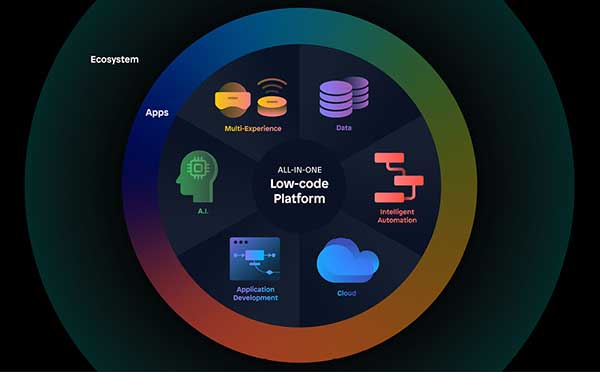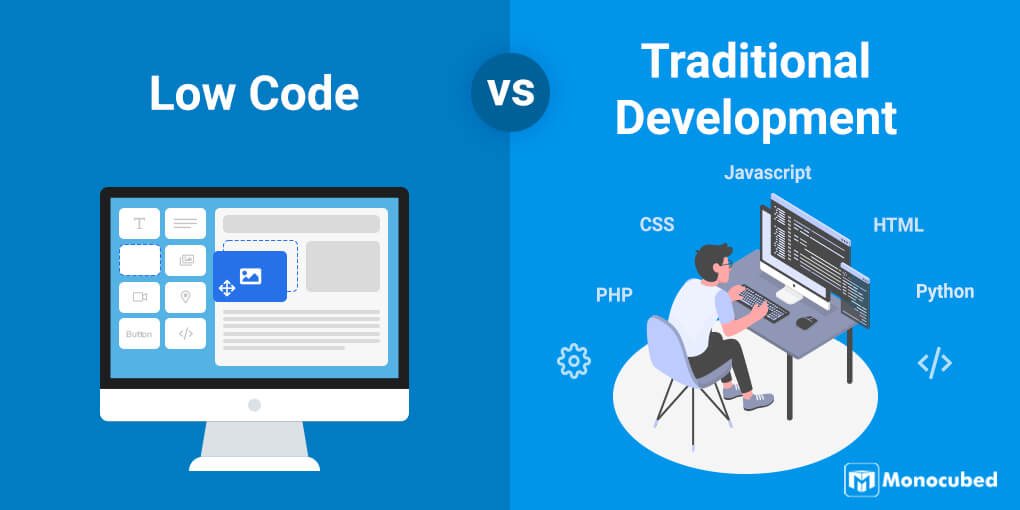Good Ideas On Deciding On Legacy application modernization with Low-code
The Benefits Of Low-Code Programming For Developing Applications As It Pertains To Integration CapabilitiesLow-code app development has many benefits, especially in terms integration. This is important for creating applications that can effortlessly connect to platforms and services. Here are some of the benefits that come with connectors that are pre-built, APIs, as well as other tools:
Wide Selection of Connectors. Low-code systems typically include an array of built-in connections to the enterprise system that are widely used (e.g. cloud services, databases, CRM). Integration of the systems can be made easier.
API Integration: Many Low-Code platforms include out-of box API integration capabilities, which allow developers to effortlessly connect external services as well as data resources.
Easy to use:
Integrations using Drag and Drop: Integrations can be created by using drag and drop interfaces. Both developers and non-developers can do this without having to write lengthy code.
Visual Workflow Designers: These software tools assist you in understanding and implementing integrations with greater ease.
Standardized Integration Methods:
SOAP and Restful Services: Using standard web service protocols such as SOAP and REST allows you to integrate with other systems and applications.
OData Standards: OData standards allow for the easy manipulation and accessibility of data across a variety of platforms and applications.
Real-Time Data Synchronization:
Real-Time Integrations: Lowcode platforms can handle data synchronization at a real-time rate between the system and applications, ensuring data is always up-to-date and consistent across an company.
Event-Driven Architectures: A few platforms have event-driven architectures which enable applications to react in real-time when certain events happen, which is essential for dynamic applications.
Legacy System Integration:
Low-code Platforms: These platforms could be utilized to connect older systems to the latest. They're a great method to upgrade your IT infrastructure without the need to completely overhaul your IT infrastructure.
Data Migration Tools: These built-in instruments to migrate data facilitate the transfer from old systems to software developed using low-code platforms.
Integration of third-party services:
Cloud Services Integration: The seamless integration of cloud services, like AWS Azure, Google Cloud makes it easy to deploy and scale-up of applications.
Business Applications Integration: Low code platforms are able to be integrated with other business applications such as Salesforce, SAP and Microsoft Dynamics. This facilitates seamless flow between different business processes.
Simplified Data Management:
Unified data models: Some platforms provide low-code support for unified data models to simplify data management across different systems.
Data connectors: Preconfigured data connectors give easy access and control to data from a variety of sources.
Security and Compliance
Secure Integrations: Low-code platforms ensure that integrations comply with security protocols and standards, assisting to protect data during transit and at rest.
Compliance Features: These platforms often have features to ensure that integrations meet the requirements of regulatory agencies (e.g., GDPR, HIPAA), providing security for companies dealing with sensitive data.
Extensibility:
Custom Code and Scripts: To meet more complex integration needs, low-code platforms often permit the use of custom scripts and code which allows flexibility but without compromising the user-friendliness of the.
Plug-in Ecosystems. A community of extensions and plug-ins allows you to enhance your integration abilities, adding new features whenever you need to.
All in all low-code development platforms have robust integration capabilities that make them an excellent tool for building functional and interconnected applications. They simplify the process of connecting disparate system, improve data flow, and permit companies to take advantage of innovative technologies while also leveraging existing ones. View the most popular Low-code Platform for application development for website recommendations including application modernization software, application modernization, ms azure sql, build with docker, cloud software applications, develop web application, develop web app, application modernisation, app development platform, rad application development and more.

The Cost-Effectiveness Of Low-Code Development Is One Of The Main Advantages.
Low-code applications offer a variety of advantages when it comes to cost-effectiveness. Businesses that are looking to optimize budgets can benefit from this method while still delivering high-quality applications. Here are the key advantages: Lower development costs:
Less Coding Required: Low-code platforms minimize the need for a lot of hand-coding, which reduces the time and effort that developers need to put into developing applications. This means lower cost of labor.
Less Developer Resources: Because low-code development is faster and easier, fewer developers are required. This can dramatically reduce hiring and staffing expenses.
Speedier Time to Market
Accelerated development cycle: Visual development tools and prebuilt components offered by low-code platforms enable rapid application development. This allows businesses to get their products to go to market faster. This could result in faster revenues and better position in the marketplace.
Rapid prototyping: By creating and testing prototypes in a short time companies can cut down on the time they spend in the development stage and also allow for faster iterations based on user feedback.
Reduced Maintenance Costs
Simpler maintenance: Low-code platforms, with their modular components and standardised components make them easier to maintain. It helps reduce costs for maintenance and support.
Automated Updates. Many low-code platform handle patches and updates automatically. Applications remain safe without needing extensive manual input.
Efficient Resource Utilization:
Contributions by non-developers: Low-code platforms enable non-developers for example, business users to participate in the process of development. This democratization of development processes enables businesses to utilize the skills and abilities of a broader variety of employees.
Optimized Use Of IT Resources: IT teams can concentrate on strategic projects instead of getting bogged down with mundane development work, improving efficiency and productivity overall.
Modular Pricing Models that Scale:
Subscription-Based Pricing: A lot of lowcode platforms have flexible, subscription-based pricing plans that rise as users use them. This allows companies to align their spending with their needs and future growth, avoiding large initial cost.
Pay-Assosiated Option: A few platform providers offer pay-assosiated options. These options ensure that companies are only liable for the services they use, which is beneficial to small and new businesses that have limited resources.
Reduced Third-Party Software costs:
Low-code platforms are often equipped with functions that are integrated, eliminating the requirement to purchase additional tools or software. This can help you save money on subscriptions and software licensing fees.
Pre-Built Integrations: Availability of pre-built integrations for popular platforms and services eliminates the need for custom development, saving both time and money.
Better ROI:
A faster return on investment (ROI): By making use of the rapid development process, less expense and a quicker time to market, businesses are able to achieve an increase in ROI for their apps.
Increased Ability. Businesses can adapt quickly to changing market conditions and customer needs. This helps them remain relevant, and they can take advantage of any new opportunities.
The cost of training is less:
User-Friendly Interfaces: Low code platforms are user-friendly and have simple interfaces that reduce the time required to learn.
Accessible Resources - Many low code platforms come with comprehensive instructional materials and tutorials and also community assistance. These resources reduce the requirement for formal instruction and its associated costs.
Streamlined collaboration:
Enhanced Collaboration Tools : The collaboration tools built-in to the software facilitate collaboration and communication between the team members. This leads to a more efficient project development and lower overhead.
Unified Development Environment: A single unifying development environment can help improve workflows and reduces difficulties and expenses associated with managing multiple tools and platforms.
Overall, the efficiency of software development using low-code can be attributed to its ability to lower the cost of maintenance and development, increase time to markets as well as optimize the use of resources and offer flexible pricing models. These factors provide substantial economic benefits to companies. Low-code development is an excellent choice for organizations that want to maximize budgets but still build robust, scalable, and high-quality software. Check out the top rated Legacy application modernization with Low-code examples for site recommendations including jdbc server, application modernisation, sso azure, app development platform, application modernization, app development platform, azure sql databases, cross platform mobile dev, driver jdbc, ms azure sql and more.

The Benefits Of Low-Code Development For Developing Applications With Respect To Limitations And The Possibility Of Customization
Low-code applications offer an integrated approach that offers important advantages in terms of dealing with limitations and permitting modification. Here are a few main benefits:Handling limitations:
In overcoming Complexity Barriers:
Simplified Development : Low-code platform reduces the complexity of development by providing templates and components that have been pre-built, which allows for faster creation and deployment.
Guided Workflows Many platforms have wizards and workflows to guide developers through complicated processes. This reduces the chance of errors while also ensuring the consistency of.
Scalability Solutions
Scalability built-in: Lowcode platforms usually include features that enable an scalable architecture. They allow applications to handle growing loads without major changes.
Performance Monitoring: The tools which monitor and optimize performance help to ensure that the applications are effective, even when they grow.
Security and Compliance
Integrated Security Features: Low-code platforms come with built-in security measures such as encryption, role-based access control and automated checks for compliance to address security issues that are common.
Platforms are constantly changing their security procedures and methods of compliance, which guarantee that applications are safe from new threats.
Customization Options:
Extensibility:
Custom Code Integration: Low-code systems often allow the integration of custom code (e.g., JavaScript, Python) which allows developers to extend the functionality beyond the standard offerings.
Developers can create customized plugins and modules with functions that can be that are tailored to the specific requirements of a business.
APIs and Integration
API Support - The extensive API support facilitates seamless integration with other services and systems and allows for complete customization.
Third-Party Services : Low-code platforms usually provides pre-built connections for popular services from third parties making integration and customizing easy.
Flexible Design for UI/UX:
Customizable interfaces: Users can modify and create their own user interfaces, that will give an experience that is more customized.
Responsive Design: The apps can be adapted to fit various screen sizes and devices.
Business Logic Customization
Visual Workflow Builders: Visual tools that allow you to create and modify workflows, business logic and processes enable developers to design complicated and customized processes without lengthy programming.
Platforms can provide conditional logic to meet certain business requirements or scenarios.
Data Management:
Custom Data Models Developers have the ability to develop custom data models specifically for particular applications, tailoring data handling to meet specific business needs.
Advanced Data Processor: The combination of sophisticated data processing tools and capabilities permits the customization of how data is processed and used in the application.
Balanced Limitations and Customization
Frameworks & Standards
Low-code platforms support industry standards and best practices. This results in applications of high-quality that are scalable and safe.
Governance Frameworks built-in governance frameworks guarantee that customizations do not compromise the integrity, security or security of the application.
Iterative Development & Feedback
Rapid Prototyping: The capacity to rapidly prototype and test changes allows developers to modify their designs based on feedback from users, refining the application to meet the needs of users.
Low-code platforms are built to allow for continuous advancement. This permits customizations and upgrades as the business needs change.
User Empowerment
Empowering Citizen Developers: By enabling non-developers to make customizations through intuitive interfaces, low-code platforms increase the pool of contributors who can customize and enhance applications.
Training and Support: Many platforms offer a wealth of training and support that can assist users in making effective customizations, without compromising application stability or performance.
Low-code applications offer a flexible framework which can be customized to meet specific needs. This allows businesses to build and maintain apps that are efficient, adapted to their particular requirements and adhere to high standards in terms of security, quality and scalability.
